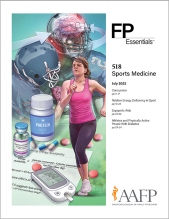
This clinical content conforms to AAFP criteria for CME.
Sports-related concussion is a common injury in organized and recreational sports. Collision and contact sports are higher risk activities. Female athletes may be at more risk of concussion compared with male athletes; however, more research is needed. Evaluation of concussion involves assessments of multiple domains or clinical profiles, including vestibular, ocular, headache, cognitive, mood, fatigue, and other systems. Initial management consists of a short rest period followed by increasing activity that does not exacerbate symptoms. Cognitive modifications for school or work also are initiated early in the management plan. Use of other management modalities is based on findings from the physical examination. Imaging may be needed in cases of worsening or progressive symptoms. When athletes have returned to baseline symptom burden and have returned to school or work, they may transition to a return to play/sport progression. Most sports-related concussions resolve within 2 weeks for adults and 4 weeks for adolescents. Risk factors for prolonged recovery include initial high symptom burden, multiple concussions, young age, mental health issues, and migraine history.
Case 1. HG is a 20-year-old college student with 2 days of headache, fatigue, and dizziness. Symptoms began the day after an intramural soccer match in which she was elbowed in the side of the head while going for the ball. She did not lose consciousness or experience symptoms at the time of injury other than scalp tenderness. Now, she is having trouble concentrating on a writing assignment and preparing for upcoming examinations. You recommend that she suspend her studies to allow time for recovery. She resists this recommendation.
Subscribe
From $350- Immediate, unlimited access to FP Essentials content
- 60 CME credits/year
- AAFP app access
- Print delivery available
Edition Access
$44- Immediate, unlimited access to this edition's content
- 5 CME credits
- AAFP app access
- Print delivery available
